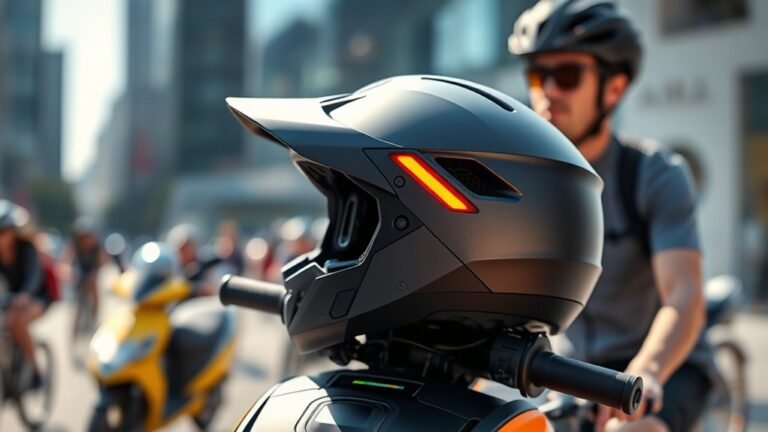Helmet Laws for Electric Bikes and Scooters
Helmet laws for electric bikes and scooters vary widely across the globe, impacting your safety and freedom. In some countries, like Germany, helmets are mandatory to protect riders, while others, like the Netherlands, prioritize individual choice. Proponents argue helmets reduce injury risk considerably, while opponents emphasize personal autonomy. As regulations evolve, understanding the balance between safety and freedom in urban mobility is essential. Explore how these dynamics shift in different regions and their implications for you.
The Rise of Electric Bikes and Scooters

As cities grapple with congestion and pollution, the rise of electric bikes and scooters has emerged as a viable solution for urban mobility. These vehicles align with current urban transportation trends, offering an eco-friendly alternative that enhances personal freedom. You’ll find that electric mobility growth reflects a shift in consumer preferences, as more individuals seek efficient, cost-effective travel options. They’re not just convenient; they also reduce reliance on traditional vehicles, easing traffic and lowering emissions. With infrastructure improvements and increased accessibility, electric bikes and scooters are becoming integral to urban landscapes. This shift signifies a broader movement towards sustainable living, empowering you to navigate cities in a more liberated, health-conscious manner. Embracing this change can redefine how you experience urban life.
Understanding Helmet Laws: A Global Perspective

While helmet laws for electric bikes and scooters vary considerably across the globe, they play an essential role in promoting safety and reducing injury rates among riders. Global helmet trends reveal a patchwork of regulations shaped by cultural attitudes towards personal freedom and safety. In countries like Germany, mandatory helmet laws are common, reflecting a proactive approach to rider protection. Conversely, nations such as the Netherlands prioritize cyclist freedom, often resulting in more lenient regulations. This divergence highlights the balance between individual liberties and community safety. Understanding these varying perspectives can inform your own decisions about helmet use, encouraging a thoughtful approach to riding that respects both personal choice and public health.
The Argument for Mandatory Helmet Use

Mandatory helmet use for electric bikes and scooters is often justified by the significant reduction in head injuries associated with wearing helmets. Here are some compelling reasons to evaluate:
- Helmet Effectiveness: Studies show helmets can reduce head injury risk by up to 85% in accidents.
- Safety Statistics: Regions with mandatory helmet laws report fewer severe injuries and fatalities among riders.
- Public Health: Lower injury rates lead to reduced healthcare costs, benefiting society as a whole.
- Encouraging Safe Practices: Mandating helmets promotes a culture of safety, encouraging responsible riding behavior.
The Case Against Helmet Regulations
Although helmet regulations are aimed at improving safety, there are valid arguments against their enforcement that merit consideration. Many believe that personal choice should dictate whether or not to wear a helmet, rather than government mandates. When individuals are given helmet exemptions, they can make informed decisions based on their own risk assessments. This approach respects individual autonomy and encourages responsible behavior. Additionally, strict regulations can deter people from using electric bikes and scooters, ultimately reducing the potential for eco-friendly transport options. By promoting personal freedom, we foster a culture of responsibility where riders can weigh the pros and cons for themselves. In this light, the debate surrounding helmet regulations deserves a nuanced examination.
Regional Variations in Helmet Laws
When it comes to helmet laws for electric bikes and scooters, you’ll find significant differences across states. Some regions impose strict regulations, while others only require helmets for specific age groups. Understanding these variations is essential for ensuring compliance and safety in your area.
State-Specific Regulations
As helmet laws for electric bikes and scooters vary considerably across states, it’s vital to understand these differences if you’re planning to ride. Here are some key points about state-specific regulations:
- Mandatory Helmet Laws: Some states require all riders to wear helmets, regardless of age or type of vehicle.
- Partial Requirements: Certain states have laws that mandate helmets only for specific age groups.
- No Helmet Laws: A few states have no helmet requirements at all, promoting personal choice.
- Enforcement Challenges: Variations in state regulations can lead to inconsistent enforcement, making it important to know local laws.
Being informed about these regulations enhances your riding experience and guarantees your freedom isn’t compromised by legal misunderstandings.
Age Restrictions
Understanding age restrictions related to helmet laws is essential for electric bike and scooter riders. Regulations vary widely by region, affecting youth participation in these activities. In many areas, riders under a certain age—often 18—are required to wear helmets, promoting safety education among younger users. This approach not only emphasizes the importance of safety but also encourages responsible riding habits from an early age. However, in regions with more relaxed laws, youth may ride without helmets, potentially jeopardizing their safety. Balancing freedom with safety is vital; effective youth participation programs can foster a culture of responsibility while respecting riders’ autonomy. As laws evolve, staying informed about local regulations will empower you to make safe choices and advocate for better safety education.
Impact of Helmet Use on Rider Safety
Wearing a helmet while riding electric bikes and scooters greatly reduces the risk of head injuries during accidents. This protective gear not only safeguards your health but can also enhance your confidence, allowing you to navigate urban environments more freely. Understanding these impacts can help you make informed decisions about your safety while riding.
Reduced Head Injuries
While many riders may underestimate the risks associated with electric bikes and scooters, studies consistently show that wearing a helmet considerably reduces the likelihood of head injuries in the event of an accident. The benefits of helmet use for injury prevention include:
- Reduced risk of traumatic brain injuries.
- Diminished severity of head injuries when accidents occur.
- Enhanced protection against falls, especially in urban environments.
- Increased awareness of safety standards among riders.
Increased Rider Confidence
Helmet use not only plays a critical role in reducing head injuries but also greatly boosts rider confidence. When you wear a helmet, you’re not just enhancing your safety; you’re also fostering a sense of rider assurance. This assurance can be pivotal, especially for those new to electric bikes and scooters. Knowing you’re protected allows you to navigate traffic and unfamiliar routes with greater ease. This confidence building doesn’t just affect your riding experience; it can also encourage others to adopt similar safety measures. As more riders embrace helmets, a cultural shift toward prioritizing safety and responsibility emerges, allowing for a more liberated riding environment where everyone can enjoy their freedom with peace of mind.
The Role of Education in Promoting Safety
Education plays an essential role in enhancing safety for electric bike and scooter users, as it equips riders with the knowledge they need to navigate traffic and understand the importance of protective gear. Implementing effective education initiatives and safety campaigns can greatly reduce accidents and injuries. Here are four key components of such programs:
- Traffic Laws: Understanding local regulations specific to electric bikes and scooters.
- Protective Gear: Emphasizing the importance of helmets and other protective equipment.
- Safe Riding Techniques: Teaching the best practices for handling vehicles in various conditions.
- Emergency Response: Preparing riders for potential accidents and how to react effectively.
Public Perception of Helmet Laws
Many people hold varying opinions on helmet laws for electric bikes and scooters, reflecting a complex mix of safety concerns and personal freedoms. Public opinion often leans towards the belief that individuals should have the autonomy to choose whether or not to wear a helmet. Cultural attitudes also play a significant role; in some regions, helmet use is seen as a standard safety measure, while in others, it’s viewed as an unnecessary regulation that infringes on personal rights. This divergence can create tension between safety advocates and those who prioritize freedom of choice. Ultimately, addressing these differing perspectives is essential for developing policies that balance safety with individual liberties, ensuring that regulations resonate with the values of the communities they serve.
Future Trends in Regulation and Safety
As public perception continues to evolve, the future of helmet laws for electric bikes and scooters is likely to reflect a growing emphasis on both safety and personal choice. Key trends to watch include:
- Future Innovations: Expect advancements in helmet technology, like integrated communication systems and smart sensors.
- Regulatory Challenges: Legislators will need to navigate the balance between public safety and individual freedoms.
- Data-Driven Policies: Regulations may increasingly rely on data analytics to assess risk and inform decisions.
- Public Engagement: Increased dialogue between riders, manufacturers, and regulators could lead to more tailored laws that respect personal choice.
In this landscape, staying informed and engaged will be essential as you navigate the evolving regulations surrounding electric bikes and scooters.
Balancing Freedom and Safety in Urban Mobility
While the rise of electric bikes and scooters offers unprecedented freedom in urban mobility, it also raises significant questions about safety and regulation. You might appreciate the flexibility these modes of transport provide, allowing for quick, efficient travel without being tethered to traditional vehicles. However, this freedom often clashes with the need for regulation aimed at ensuring safety for all road users. Striking a balance between freedom vs. regulation is essential. On one hand, you want the liberty to ride without excessive restrictions; on the other, you understand that reasonable safety measures, like helmet laws, can protect riders and pedestrians alike. Ultimately, fostering an environment where freedom and safety coexist is vital for the future of urban mobility.
Frequently Asked Questions
Are There Age Restrictions for Helmet Use in Different Regions?
Picture a world where helmets are magical crowns—age restrictions for wearing them vary wildly by region! You’ll find some areas enforcing strict helmet age regulations, while others throw caution to the wind, letting anyone ride freely. Regional helmet requirements can feel like a game of roulette, so it’s essential to know the rules before you cruise. After all, freedom’s great, but it shouldn’t come with a surprise visit from the helmet police!
How Do Helmet Laws Affect Insurance Coverage for Riders?
Helmet laws can greatly impact insurance coverage for riders. When you wear a helmet and comply with regulations, it often reduces your liability in the event of an accident, which can lead to lower insurance premiums. Conversely, if you’re caught without a helmet in a jurisdiction that requires one, your liability could increase, potentially raising your premiums. Understanding these implications can help you make informed decisions about your safety and financial responsibilities.
What Types of Helmets Are Legally Acceptable for Electric Bikes?
When you’re riding your electric bike, a helmet that meets DOT or CPSC standards is essential. For instance, if you choose a helmet with a high safety rating, like a MIPS-equipped model, you’re opting for enhanced protection against rotational forces. These helmets not only comply with legal requirements but also provide peace of mind while you enjoy your ride. Always check for approved helmet standards to guarantee you’re riding safely and legally.
Do Helmet Laws Apply to Rental Electric Scooters?
Yes, helmet laws often apply to rental electric scooters, depending on local regulations. When you rent a scooter, the rental agreement usually includes safety regulations, which may mandate helmet use. It’s crucial to check the specific laws in your area, as some places prioritize your freedom to ride without a helmet, while others enforce strict safety measures. Understanding these laws can help you make informed decisions about your ride and guarantee your safety.
Are There Penalties for Not Wearing a Helmet While Riding?
Yes, there are often penalties for not wearing a helmet while riding. Helmet enforcement varies by location, and it typically falls under local traffic laws. As a rider, it’s your responsibility to know and comply with these regulations. Ignoring helmet laws can lead to fines or other consequences, which may impact your freedom to ride. Staying informed about the rules in your area guarantees a safer and more responsible riding experience.






